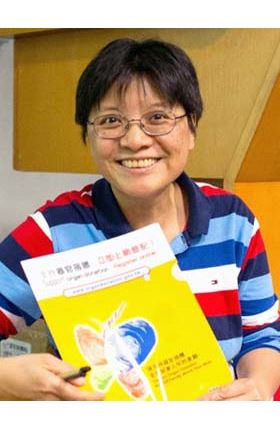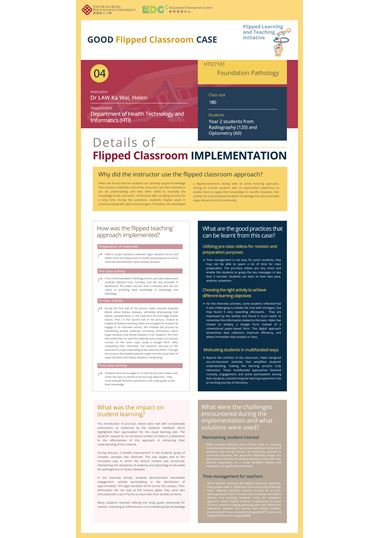
General Information
- Instructor: Dr LAW Ka Wai, Helen
- Department: Department of Health Technology and Informatics
- Subject: HTI27101 Foundation Pathology
- Class Size: 180
- Students: Year 2 students from Radiography (120) and Optometry (60)
Why Use the Flipped Classroom Approach?
Helen has found that her students can certainly acquire knowledge from lectures, textbooks and online resources, but their experience can be unstimulating and they often failed to translate the knowledge to the real world. Particularly after studying at home for a long time during the pandemic, students maybe weak in communicating with peers and strangers. Therefore, she developed a flipped-classroom activity with an active learning approach, aiming to provide students with an experiential experience to enable them to apply their knowledge in real-life situations. Her activity not only enhanced students’ knowledge but also promoted organ donation in the community.
Implementation Steps
Preparation of materials
Helen’s project assistant collected organ donation forms and folders from the Department of Health and prepared an online interview questionnaire about kidney diseases.
Pre-class activity
Prior to the Foundation Pathology lecture, pre-class videos were carefully selected from YouTube, and the link provided in Blackboard. The videos are less than 5 minutes each but are useful in providing basic knowledge in physiology and pathology.
In-class activity
During the first half of the lecture, Helen covered essential details about kidney diseases, ultimately emphasising that kidney transplantation is the treatment for End Stage Kidney Failure. Then, in the second half of the lecture, instead of traditional didactic teaching, Helen encouraged her students to engage in an interview activity. She initiated the process by distributing printed materials containing information about organ donation and kidney disease to her students. She then instructed them to read the materials and conduct on-campus surveys on the same topic using a Google Form. After completing their interviews, the students returned to the classroom to have a debriefing of the collective efforts. Through this process, the students gained insight into the actual state of organ donation and kidney disease in Hong Kong.
Post-class activity
Students were encouraged to re-visit the pre-class videos and revise the topic to reinforce the learning objectives. They could attempt the short questions in the study guide to test their knowledge.
What Impact Did This Have on Student Learning?
The introduction of pre-class videos were met with considerable enthusiasm, as evidenced by the students' feedback, which highlighted their appreciation for the visual learning aids. The students' request for an increased number of videos is a testament to the effectiveness of this approach in enhancing their understanding of the material.
During lectures, a notable improvement in the students' grasp of complex concepts was observed. This was largely due to the innovative way in which the lecture content was structured, intertwining the disciplines of anatomy and physiology to elucidate the pathogenesis of various diseases.
In the interview activity, students demonstrated remarkable engagement, actively participating in the distribution of approximately 150 organ donation forms across the campus. Their enthusiasm did not stop at the campus gates; they were also entrusted with a set of forms to share with their families at home.
Many students reported utilizing the study guide extensively for revision, indicating its effectiveness in consolidating their knowledge.
What Are the Good Practices That Can Be Learnt from This Case?
Utilizing pre-class videos for revision and preparation purposes
Time management is not easy for junior students, they may not be able to spare a lot of time for class preparation. The pre-class videos are very short and enable the students to grasp the key messages in less than 5 minutes. Students can learn at their own pace, anytime, anywhere.
Choosing the right activity to achieve different learning objectives
For the interview activities, some students reflected that it was challenging to initiate the chat with strangers, but they found it very rewarding afterwards. They are impressed by the activity and found it much easier to remember the information related to the topic. Helen has chosen to employ a Google Form instead of a conventional paper-based form. This digital approach streamlines data collection, improves efficiency, and allows immediate data analysis in class.
Motivating students in multifaceted ways
Beyond the confines of the classroom, Helen designed out-of-classroom activities that amplified students’ understanding, making the learning process truly interactive. These multifaceted approaches fostered curiosity, engagement, and active participation among their students, transforming the learning experience into an exciting journey of discovery.
What Were the Challenges Encountered During the Implementation and What Solutions Were Used?
Maintaining student interest
While students dedicate most of their time to acquiring fundamental knowledge, they occasionally face moments of boredom and waning interest. By immersing students in real-world scenarios, this approach effectively bridges the gap between theoretical concepts learned in class and their practical application. As a result, students’ interest and motivation are significantly enhanced.
Time Management for teachers
When teachers embrace the flipped classroom approach, they grapple with a significant time-consuming challenge. Helen diligently searches external sources for succinct, well-organised content. She also tries to employ new staff to develop new teaching materials using the metaverse approach, which enables students to participate in virtual 3D tours related to imaging pathology after class. Within this metaverse, students can interact with various facilities, including skull X-rays, computer tomography (CT) scans, and Magnetic Resonance Imaging (MRI).

